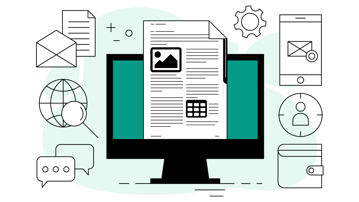Tenders are crucial for businesses operating in the international market. Whether it's an Invitation to Tender (ITT), or a Request for Proposal (RFP), tender planning is essential to setting the stage for success. These opportunities often involve substantial contracts that can significantly impact your business's revenue and growth.
This blog equips you with expert insights and best practices to help you plan efficiently and increase your chances of winning:
Challenges in the Tendering Process
Once the invitation to tender (ITT) is received, your response clock starts ticking. Early coordination is essential. Teams work long hours, juggling competing priorities and coping with changing requirements and feedback. All of this takes time.
Addressing these challenges with careful and thoughtful planning up-front gives you more time to develop a high-quality, winning response.
- Complex Documents: The documents can be complex, requiring careful analysis to fully understand.
- Tight Deadlines: Many have short deadlines, requiring “all hands on deck” for effective turnarounds.
- Competition: In competitive bidding environments, where multiple vendors vie for the same opportunity, strategic planning is what sets you apart.
- Regulatory Compliance: Adhering to regulations and standards is time-consuming and challenging.
- Complex Proposals: The more complex the requirements, the longer it takes to prepare the level of detail required.
Tender Planning: Set the Foundation for a Strong Proposal
Good preparation increases your chances of succeeding in the bidding process. It gives you the time to analyze, strategize, and tailor your bid to stand out from the competition.
Only submit a bid after a clear go/no-go decision that aligns with your goals and delivery capacity. Follow these steps to increase your chances of winning outcomes:
Respond to Possible Pre-Qualification
Before they officially invite bids, agencies often conduct a pre-qualification round to shortlist credible vendors. This may involve registering on a supplier portal, completing a detailed questionnaire, or submitting a mini-proposal.
Don’t underestimate this opportunity. We’ve seen cases where an enterprise secured work by doing such a good job at the pre-qualification stage that the buyer changed their strategy—heading straight to negotiations and contract, taking everyone by surprise. By reverse-engineering your approach from the desired contract award, you ensure that each part of your submission is aligned with the outcome evaluators are aiming for.
This is your opportunity to create a positive first impression that carries over into the evaluation phase.
- Present your company as a polished and professional supplier.
- Set yourself apart as a trusted thought-leader and problem-solver.
- Communicate with the organization and potentially influence their thinking.
Analyze Tender Documents and Bid Evaluation Criteria
Thorough analysis involves carefully examining the documents to understand the requirements and how you will be evaluated. It also provides valuable insights into the client’s thought process and potential concerns.
- Analyze the Requirements: Ensure your approach is tailored to meet the project’s technical, financial, and operational expectations.
- Understand the Evaluation: Thoroughly review the bid evaluation criteria to understand how each section of your response will be scored.
- Take Note of Anything Vague: Identify vague or ambiguous requirements or language. Decide if you should submit for clarification, or write your interpretation as part of your proposal narrative.
- Understand How the Pricing Works: Pricing may be based on predefined rate cards, resource models, or outcome-based contracts, so be sure to align accordingly.
- Delivery: Understand the submission requirements, such as hard copies, digital or portal. Understand the separation of content, such as priced vs not priced volumes.
Develop a Winning Strategy for the Bidding Process
Without a well-defined strategy, your invitation to submit proposal is unlikely to engage your client.
By crafting a pre-writing strategy, you will tell a more compelling story, and position your business as the ideal partner to tackle the challenge.
- Identify Your Approach: Define how you will capture the client’s attention and solve their problem.
- Create a Value Proposition: Clearly articulate the unique value you bring, and back that up with evidence.
- Highlight Strengths: Define where you are strong, where you struggle, and how that compares to the competition.
- Storyboard the Narrative: Visually communicate the narrative flow to ensure everyone understands.
- Address Concerns: Identify potential objections and how you would address them.
- Assess Risks: Identify potential risks and create contingency plans to minimize.
Set Up Your Response Template for a Strong Bid Submission
Your response template is the foundation for a compliant and highly readable proposal. It also reduces the likelihood of missing any requirements.
Follow the instructions, but look for opportunities to communicate your message within those requirements.
- Outline: Breakdown contractual, commercial, and technical volumes, and separate priced and unpriced versions.
- Requirements: Unless prohibited, reproduce each requirement, followed by your response.
- Numbering and Indexing: Unless specified, mirror the tender’s numbering. This helps evaluators tie together their questions and your answers.
- Layout: Reiterate your value through headings, subheadings, call-boxes and visuals.
Assemble a Strong Team
Just like a team sport, your response documents require experts that work well together toward their common goal. The right team, equipped with the necessary skills, experience, and information, can significantly enhance your chances of convincing evaluators.
- Budgeting: Develop a realistic budget that covers all resource costs.
- Assemble Expertise: Gather the necessary skills, including experts and managers.
- Assign Tasks: Define each person’s role and responsibility, including tasks and deadlines.
- Workload Balancing: Ensure contributors have the capacity to take on additional responsibilities without compromising their workload.
- Resource Allocation: Ensure resources can meet deadlines and deliver quality results.
Prepare the Writers Package
Time limits are not always the problem. Subject matter experts may just need clearer guidance to explain your value proposition clearly.
A typical writer’s package outlines the details your team needs to use their time wisely. It also makes them more effective writers, reducing revisions:
- Interpretation: Interpret the meaning (to the client) of each section or requirement and who will evaluate.
- Win Themes: Identify messages that promote your value and guide readers.
- Strong Opening: Suggest a statistical or anecdotal opening that clearly articulates your value for each section or requirement.
- Strong Closing: Suggest a closing that reinforces your value, summarizes the benefits, and transitions to the next section.
Parallel Activities
While proposal writing is critical, planning parallel tasks ensures a smoother process. Your bid submission must follow every requirement—format, delivery, and deadlines—to avoid disqualification.
These activities can include:
- Gather Documentation: Such as financial, references, and certifications. Review for accuracy and formatting.
- Pricing: Develop a model based on scope, or requirements, conditions, risks, penalties and incentives.
- Graphic Design: Plan for visuals that may require different types of software to convert into a practical format.
- Job Scheduling: Plan for complex detail and how to develop, or convert it, to meet submission requirements.
- Contract Review: Work with your legal team to document exceptions or qualifications. Plan for converting these into the format required.
- Testing or Simulations: Set aside time to convert this complex information into the required format.
- Production and Delivery: Plan the size and format to avoid last-minute surprises. For example, technical drawings may require special packaging.
Plan the Kick-Off Meeting
Kick-off typically occurs within two to three days of receiving the tender documentation. The purpose is to inform everyone that the bid has arrived, what it contains, what the pursuit strategy is, and when it is due. It is also the time to communicate tasks and deadlines and the writer’s package.
Prepare the following for you kick-off:
- Prerequisite: Distribute the documents in advance, giving your team time to read and consider.
- Participants: Involve representatives from various disciplines, such as management and business development as well as legal, finance, IT and procurement.
- Validate Strategy: Scrutinize the tender and validate your pursuit strategy.
- Tasks and Key Dates: Develop a timeline, including deadlines for different types of information.
- Clarification Process: Prepare a list of questions and open a dialogue with your team.
- Suppliers and Contractors: Set clear expectations for contractors to submit required documentation and pricing inputs. Ensure your pricing reflects all risks, incentives, and the tender’s terms and conditions.
- Management Approval: Plan for management approval as their availability is typically at a premium.
- Submission Considerations: Test how your submission will be handled in hard copy, digital, and portal upload, specifically regarding priced vs non priced versions.
Best practices
Effective planning is crucial for developing strong and competitive tender responses. Here are some best practices to consider:
- Forecast: Gather intelligence to predict with increasing certainty where and when tenders are expected.
- Plan Ahead: As intelligence advances, begin to shape your value proposition and pursuit strategy.
- Read Between the Lines: Look for phrases that express client concern, such as, “the project has a tight schedule.” Look for phrases that indicate it might have been written for someone else, such as project-specific terms.
- Educate Your Team: As the time to respond approaches, share with your team and pave the way for the kick-off.
- Provide Real-time Feedback: Write and review in-parallel to accelerate development. Real-time feedback gives contributors the facts and insights they need to advance accuracy and quality faster.
- Skip Compiling and Reformatting: Automatically enforce your layout, including headers, footers, numbering, tables, etc., to save time. Even when contributors use copy and paste.
- Plan for the Client Debrief: Prepare a list of questions in advance. Add to this list as development proceeds.
- Conduct a Lessons Learned: Reflect with your team to understand what went well and what could be improved for the next tender.
Effective preparation is crucial for developing strong and competitive responses. By investing time and effort into this, you can improve your chances of success, reduce risks, and capture those target contracts.
Preparation is essential—but to win consistently, you need more than just a plan.
If you're ready to win at scale, the right RFP response software can streamline collaboration and accelerate delivery. Take the next step with XaitPorter and empower your team to respond faster and better.












